Which is the best coating for karaage- potato starch, cornstarch, or wheat flour?
Original Japanese karaage is deep-fried by coating the chicken with potato starch or a mix of potato and wheat flour. The potato starch creates a lasting layer of crispy coating around the karaage, making it perfect for bento lunch even after it becomes cold.
Cornstarch is a good alternative to potato starch, where potato starch is hard to get. Cooks have developed various combinations of potato starch, corn flour, and wheat flour for karaage recipes. These flours are used by native Japanese, too, and all produce good results, albeit results may vary in texture and the degree of crispiness.
The following is a simple taste test of three combinations for the coating of karaage- potato starch, cornstarch, and a mix of potato starch and wheat flour to find out which one I prefer. The appearance and color of all combinations are identical after deep-frying with the same pot of oil, temperature, and duration.Cornstarch alone has a denser and crunchy texture than wheat and cornstarch after cooling for 15 minutes.Karaage with potato flour and potato/wheat flour combination have a slight feeling of raw flour to bite, which I prefer as it is a nice feeling in the mouth.The coating of potato and corn flour without the wheat flour is denser, whereas the combination of potato starch has the lightest and crispy crust.
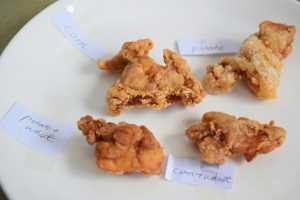 Four different combinations of flour
Four different combinations of flour
My choice: The potato starch/wheat flour combination is the best. I like the slightly floury feeling to bite and the light and crispy crust compared to corn flour alone.
And that is why I use a combination of potato starch and wheat flour in my recipe. The difference is marginal. You can use any of the combinations to achieve the result mentioned above.
Особенности
Глазированная сладким и одновременно острым соусом, такая курица – одно из любимых блюд не только самих корейцев. Некоторые даже называют ее альтернативой KFC. Тонкая корочка становится очень хрустящей от двойной обжарки, а остро-сладкий соус просто восхитителен.
Дакганжон – важная часть корейской культуры фаст-фуда. Одни из лучших мест, где продают такого цыпленка, традиционно расположены на рынках и улицах Кореи. А если курочку там готовят действительно вкусную, то за ней даже выстраиваются в очереди.



Корейцы часто наслаждаются жареным цыпленком с пивом. Для этой комбинации у них даже есть специальное название (치맥), чи от английского слова курица (치킨) и мэк от мэкджу (맥주, корейское слово, обозначающее пиво).
Дак тоже в переводе с корейского означает курица. Канчжон — это разновидность традиционных корейских кондитерских изделий. Его готовят путем обжаривания во фритюре сладкого рисового теста в виде крекеров.


Потом их покрывают сиропом, воздушным рисом, семенами кунжута или орехами. Традиционно аналогичная техника (обжаривание во фритюре и покрытие липким сиропом) также используется для приготовления различных других сладких и соленых блюд, дакганчжон – чисто куриная версия.
Air Fryer Karaage (Japanese Fried Chicken)
Make Japanese karaage in the air fryer with this easy recipe. It’s crispy and flavorful without the mess of deep frying.
4.88 from 25 votes
Prep Time 20 minutes mins
Cook Time 10 minutes mins
Marinating Time 1 day d
Course Main Course, Snack
Cuisine Japanese
Ingredients
- 1 lb chicken thighs
- 1/4 cup soy sauce
- 1/4 cup sake
- 1 tsp garlic grated
- 1 tsp ginger grated
- 1 tbsp sesame oil
- 1/2 cup flour
- 1/2 cup potato starch
- 1 tsp kosher salt
- canola oil spray
Instructions
- Cut chicken thighs roughly into cubes about 1.5 inches long
- In a bowl, mix soy sauce, sake, ginger, garlic, and sesame oil to form the marinade.
- Pour marinade over chicken, mixing well, and put in fridge to marinate at least 30 minutes, but preferably overnight.
- When ready to fry, preheat your air fryer to 390 degrees.
- Meanwhile, whisk flour, potato starch, and salt.
- Remove chicken from marinade and dredge in the dry ingredients.
- Place chicken evenly spaced in the preheated air fryer. Spray liberally with canola oil spray.
- Place in air fryer at 390 degrees F for 10-12 minutes, shaking and spraying again with oil about halfway through.
Рецепт курицы Карааге
- 600г куриных бедрышек
- ½ ч.л соли
- ½ ч.л черный перец
- 2 столовые ложки картофельного крахмала / кукурузного крахмала
- 2 столовые ложки муки
- растительное масло для жарки во фритюре
- ½ чайной ложки тертого имбиря
- 1 зубчик чеснока
- ½ столовой ложки соевого соуса
- ½ столовой ложки мирин
- ½ чайной ложки кунжутного масла
- ½ стакана сладкого соуса чили (8 ст. Ложек)
- 2 столовые ложки воды
- нарезанный зеленый лук и кинза — по вкусу
Приготовление:
1. Нарежьте каждое куриное бедро на небольшие кусочки и приправьте солью и свежемолотым черным перцем.
В большой миске смешайте имбирь, измельченный чеснок, ½ столовой ложки соевого соуса, ½ столовой ложки мирина и ½ столовой ложки кунжутного масла. Взбейте все вместе.
Добавьте курицу в миску и перемешайте руками. Накрыть крышкой и оставить мариноваться в течение 30 минут.
2. Налейте масло в кастрюлю с толстым дном и нагрейте на среднем огне.
Тем временем приготовьте картофельный крахмал и муку в 2х отдельных тарелках.
Сначала слегка обваляйте каждый кусочек курицы в муке (и удалите излишки муки), а затем обваляйте курицу в картофельном крахмале (и удалите излишки крахмала)
3
Когда масло нагреется, осторожно погрузите каждый кусочек курицы в масло. Готовьте 3-5 штук за раз
Если вы положите в масло много кусочков, температура масла будет быстро падать, и курица будет впитывать слишком много масла.
Готовьте примерно в течение 90 секунд или до тех пор, пока курица не станет светло-золотистого цвета. Если курица меняет цвет слишком быстро, значит, температура масла слишком высокая. Либо добавьте еще несколько кусочков курицы в масло, либо уменьшите огонь. Между партиями собирайте крошки в масле с помощью мелкого сита. Это сохраняет масло чистым и предотвращает его потемнение.
После того, как курица будет готова, отправьте ее на кухонное бумажное полотенце, чтобы излишки масла впитались в полотенце.
4. Теперь будет 2 степень обжарки курицы. После того, как все кусочки курицы обжарились, нужно будет проделать тоже самое по 2му кругу.
Жарьте курицу также партиями по 3-5 штук за раз уже в течение 45 секунд , или пока корочка не приобретет красивый золотистый цвет и не станет хрустящей. Переложите на решетку, чтобы слить лишнее масло, и продолжайте с оставшейся курицей.
5. Для соуса на сковороде смешать все ингредиенты, добавить зеленый лук и кинзу и перемешайте на среднем огне. Когда соус запузырится, добавить курицу и быстро перемешать в соусе — не более 15 секунд.
Подавать курицу в горячем виде.
Источник
Самое популярное
- Салаты на Новый год 2013. — 84,868 просмотров
- Чимпени — 35,157 просмотров
- Легкие салаты на день рождение. — 28,746 просмотров
- Домашняя бражка из варенья. — 27,556 просмотров
- Рецепты для сковороды-гриль. — 27,181 просмотров
- Рецепт домашнее вино из варенья. — 25,332 просмотров
- Кукси. Рецепт приготовления кукси. — 22,188 просмотров
- Ханум — 20,476 просмотров
- Соте из баклажанов. — 19,489 просмотров
- Стаканчик для мороженого. — 18,871 просмотров
- Кофе в капсулах — 18,246 просмотров
- Бешбармак — 17,900 просмотров
- Как приготовить гуся кусочками. — 17,567 просмотров
- Маринованный чеснок. — 16,447 просмотров
- Пигоди. — 16,350 просмотров
- Как потушить картошку с капустой. — 16,245 просмотров
- Рецепты с сыром фетаксой. — 15,849 просмотров
- Мясная нарезка. — 15,026 просмотров
- Карта сайта — 14,954 просмотров
- Паби. — 14,853 просмотров
Extra crunchy karaage: hailstone effect
Hailstone effect is a kind of modern term for extra crunchy karaage, well I just made it up. Imagine the hailstones, little white balls falling from the sky with great force, the texture seems hard but if you tried to eat it I’m sure it would be light and maybe even crunchy. With this recipe, you can have this hailstone effect on fried chicken! That is to say, you get an extremely crunchy texture.
Hailstone effect can be achieved just with water and starch (potato, corn or tapioca). If you mix it in certain way, you can literally make hailstones.
 This is after starch is mixed with tiny bit of water, the formed crystal will become cracker-like once cooked
This is after starch is mixed with tiny bit of water, the formed crystal will become cracker-like once cooked
The details are in the recipe card, but this is only optional for people who like extra crunchiness. You can omit this hailstone process in this recipe and it’s also fine! The only thing is, do not add too much water, otherwise it won’t work at all.
How to Make Karaage in the Air Fryer
All things considered, karaage is a very easy recipe to adapt to the air fryer. You keep most things the same, except for the marinating time, as I mentioned before. The other thing I added was an extra teaspoon of kosher salt to your breading ingredients. Again, this is to make up for the loss of oily goodness you would normally get in deep frying.
Otherwise, the technique for karaage in the air fryer is pretty much the same. Cut your chicken. Marinate. Dredge in a mixture of potato starch and flour. Air fry.
Easy peasy lemon squeezy. Literally. You often serve karaage with a squeeze of lemon at the end.

And that’s it! You can serve chicken karaage as a main dish with rice or as an appetizer. If you give this recipe a try, make sure to rate it down below and let me know how it went in the comments. Don’t forget to find me on Instagram as well!

Air Fryer Karaage (Japanese Fried Chicken)
Make Japanese karaage in the air fryer with this easy recipe. It’s crispy and flavorful without the mess of deep frying.
4.88 from 25 votes
Prep Time 20 minutes mins
Cook Time 10 minutes mins
Marinating Time 1 day d
Course Main Course, Snack
Cuisine Japanese
Ingredients
- 1 lb chicken thighs
- 1/4 cup soy sauce
- 1/4 cup sake
- 1 tsp garlic grated
- 1 tsp ginger grated
- 1 tbsp sesame oil
- 1/2 cup flour
- 1/2 cup potato starch
- 1 tsp kosher salt
- canola oil spray
Instructions
- Cut chicken thighs roughly into cubes about 1.5 inches long
- In a bowl, mix soy sauce, sake, ginger, garlic, and sesame oil to form the marinade.
- Pour marinade over chicken, mixing well, and put in fridge to marinate at least 30 minutes, but preferably overnight.
- When ready to fry, preheat your air fryer to 390 degrees.
- Meanwhile, whisk flour, potato starch, and salt.
- Remove chicken from marinade and dredge in the dry ingredients.
- Place chicken evenly spaced in the preheated air fryer. Spray liberally with canola oil spray.
- Place in air fryer at 390 degrees F for 10-12 minutes, shaking and spraying again with oil about halfway through.
Video
Tried this recipe?Click on the stars to add a rating, or add a comment below!
Keyword air fryer, chicken
If you liked this recipe, be sure to check out my air fryer mochiko chicken and air fryer tempura recipes as well!
4 Key Ingredients for Karaage
1. Chicken
In Japan, karaage is typically made with skin-on boneless chicken thighs, which has more flavor than chicken breasts. However, if you really want to use breasts, that’s okay.
Here in the US, skin-on chicken thighs are always sold with bones. To save time, I usually ask my friendly butcher to remove the bones for me. Why do we need to use skin-on? The skin keeps the karaage crispy on the outside and the meat juicy inside.
2. Marinade/Seasonings
There are so many variations of marinade/seasonings available for Karaage, and this is really up to you. I make mine slightly different all the time. However, the primary base should always include soy sauce, sake, and ginger.
Sake helps tenderize the meat while ginger gives zing and removes the gamey taste.
Some variations for the seasonings include:
- garlic
- sesame oil
- mirin
- oyster sauce
- curry powder
- egg yolk
- Japanese mayonnaise (I haven’t tried it…)
Feel free to experiment with the ingredients and see what you like!
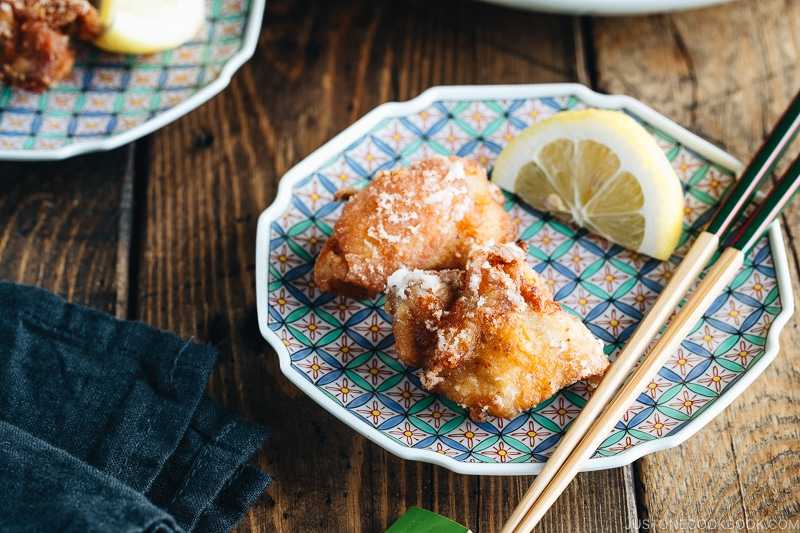
3. Coating
This is another flexibility you can work with by testing out different ratios:
- Flour – you can decide cake flour (lighter shell) or all-purpose flour (easily available in the US)
- Potato starch
- Flour + potato starch
- Rice flour + potato starch (see this recipe) – this is gluten-free!
In this recipe, I use equal parts of all-purpose flour and potato starch. I first dredge the chicken in flour and then potato starch. The flour will trap the marinade and seasonings inside the shell, and potato starch will create a crisp texture on the outside. You can premix the flour and starch, but I actually like dredging in 2 stages for the best result!
Potato starch vs. Corn starch
In Japan, potato starch (or katakuriko 片栗粉) is most commonly used as a coating for frying foods. Here in the US, corn starch is much easier to access in regular grocery stores, so that is a close substitute if you have trouble finding potato starch.
As a comparison, I found that karaage made with potato starch yields a crispier skin and texture. If you compare these two starches by rubbing them between your fingertips, you will notice the difference.
Potato starch is available on Amazon and larger grocery stores. I think it’s worth looking for it to make delicious Karaage.
Are potato starch and potato flour the same?
No, they are not the same. Potato starch is made from the dried starch component of peeled potatoes while potato flour is made from whole (raw or cooked) potatoes being dried then ground into flour.
My recommendation for deep frying oil includes:
- Canola oil (キャノーラ油)
- Safflower oil (べに花油)
- Rice bran oil (米油)
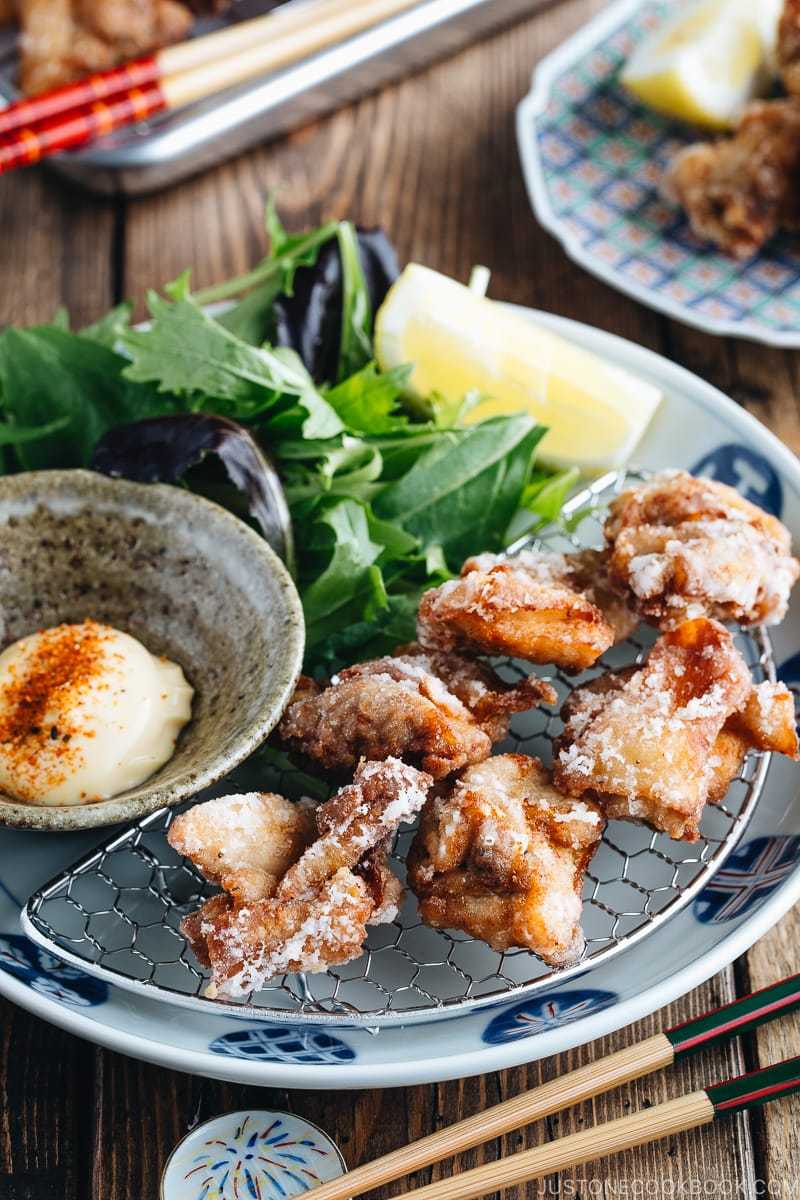
What is Karaage?
Pronounced as ‘ka-RA-AH-geh’, the word karaage refers to a Japanese cooking technique in which an ingredient is lightly coated with flour and deep-fried in oil. When you hear “karaage”, most of us assume it’s chicken karaage, but it can also be fish or vegetables.
For chicken karaage, it’s essentially bite-size pieces of chicken thigh dusted with flour and deep-fried in hot oil. With tender and juicy marinated chicken coated in a crispy shell, karaage is a staple in Japanese home-cooked meals.
You may find this delicious Japanese fried chicken being served at:
- home – it can be a main dish or appetizer.
- diner and restaurant – karaage teishoku is a popular set meal.
- Izakaya and bar – served as an appetizer to go with a drink.
- supermarket, convenience store, and depachika (B1F – the gourmet food galore in the basement of a department store).
- bento shop – karaage bento is a popular choice
Курица тори карааге
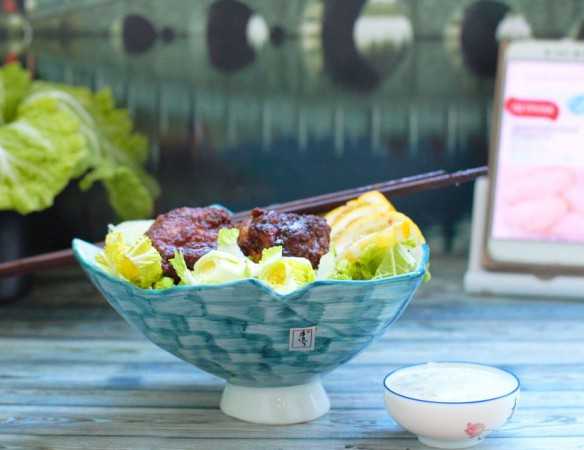
Японский ответ KFC, жареная курица по-японски. Прекрасный вариант перекуса или стрит-фуда. К нескольким кусочкам этой курицы можно подать большую миску капустного салата, лимон и йогуртовый легкий соус типа цацыки.
Классический способ подачи – долька лимона и кьюпи-майо, но мне кажется, что это будет слишком жирно. В Японии эту курицу можно встретить в любом меню, также она часто подается как закуска к пиву.
Суть этой курицы – недолгое маринование и обжаривание в крахмальной панировке. Мясо берется чаще темное с кожей или филе. Я сделала из идеально подходящих для карааге бескостных бедер с кожей.
Классический куриный карааге требует картофельного крахмала для обваливания. В Японии его называют катакурико. Можно заменить на кукурузный.
Саке заменяется китайским шаосиньским вином для готовки, Мирином, Хересом или белым сухим вином.
- Порежьте каждое куриное бедро на 3-4 части, у вас после обжарки должны получиться кусочки на один укус.
- Имбирь и чеснок натереть на терке.
- Добавить соевый соус, вино, сахар. Смешать все это и добавить курицу.
- Удобно мариновать прямо в подложке от курицы! Поставить в холодильник.
- Мариновать можно от получаса до целой ночи. Среднее время — около 40 минут.
- Смешать крахмал с разрыхлителем.
- Разогреть фритюр до средней температуры.
- Жарить хорошо, но тонко обвалянные кусочки курицы в один слой! Не бросать сразу всё, жарить по несколько кусочков.
- Можно приготовить такое мясо и в аэрогриле при наличии. На обжарку каждой партии уйдет около 5 минут.
- Обжаренные кусочки положить на бумажные полотенца для избавления от лишнего масла. можно применять решетку решетку, под которой постелены полотенца. Так низ курицы остается сухим и не размокает от собственной остаточной температуры.
- Настрогайте пекинскую капусту тонким жульеном. Приготовьте любимый соус. У меня соус из греческого йогурта, давленого чеснока, соли и тертого огурца. Очень легкий и подходящий к капусте и курице.
- Сервировать блюдо дольками лимона. Очень вкусно!
Источник
Ingredients for Karaage
According to the queen of Japanese food blogging, , karaage is traditionally made with boneless chicken thighs that have the skin still on. However, in America, it’s pretty difficult to find. Boneless, skinless chicken thighs work just fine here.
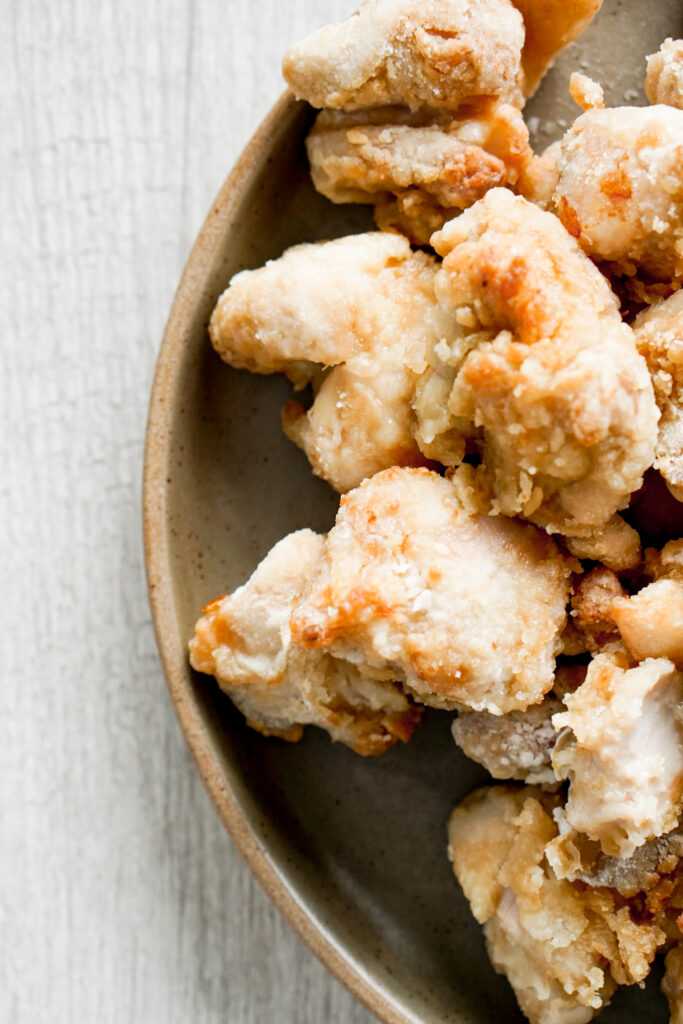
The only other special ingredient that may be difficult to find in typical American grocery stores is potato starch. In Japanese, this is called katakuriko. I usually buy this at my local Japanese market, but you can find the exact same brand I have on Amazon.
If you’re like, “What am I going to do with a bunch of leftover Japanese potato starch?” Never fear! Katakuriko is a necessary ingredient in mochi recipes to keep the mochi from sticking. You can use it with my chi chi dango recipe, or my daifuku recipes, or even to make Chinese snow skin mooncakes!
Now onto the marinade…
Источник
Стенд Карааге Dōtonbori, Осака
Часто упоминается, что карааге был популяризирован в 1920-х годах благодаря ресторану Toyoken в Беппу, Япония. Этот метод был популяризирован из-за нехватки продуктов питания в Японии после Второй мировой войны, особенно для курицы. Курица уже была популярной едой, но использование метода Карааге упростило ее приготовление и предоставило другой способ есть курицу.
Истоки стиля приготовления пищи также можно найти в китайской кухне, она очень похожа на то, как они жарить тофу для вегетарианских блюд. Однако способ жарки появился со времен темпуры в Японии в период Эдо. Они используют соевый соус и рисовое вино, процесс, аналогичный стилю японской кулинарии карааге.
С 1920-х годов блюдо широко распространилось по всей Японии. Карааге в основном относится к жареному цыпленку, поскольку жареный цыпленок стал самой распространенной версией стиля приготовления. Карааге — версия с курицей — обычно продается в таких магазинах, как Лоусон, Семейный магазин, и 7/11 как блюдо быстрого питания. Он также легко доступен в киосках с едой по всей Японии.
Когда он покрыт крахмалом, он называется Тацута-агэ. Тацута — это название реки, но существуют противоречивые теории относительно того, почему ее так назвали.
Карааге также широко доступны на фестивалях и в продуктовых лавках по всей Японии. Одним из таких фестивалей является Оита ежегодный фестиваль Карааге, в котором участвуют более 60 различных магазинов, предлагающих уникальные версии японских деликатесов.
Serving
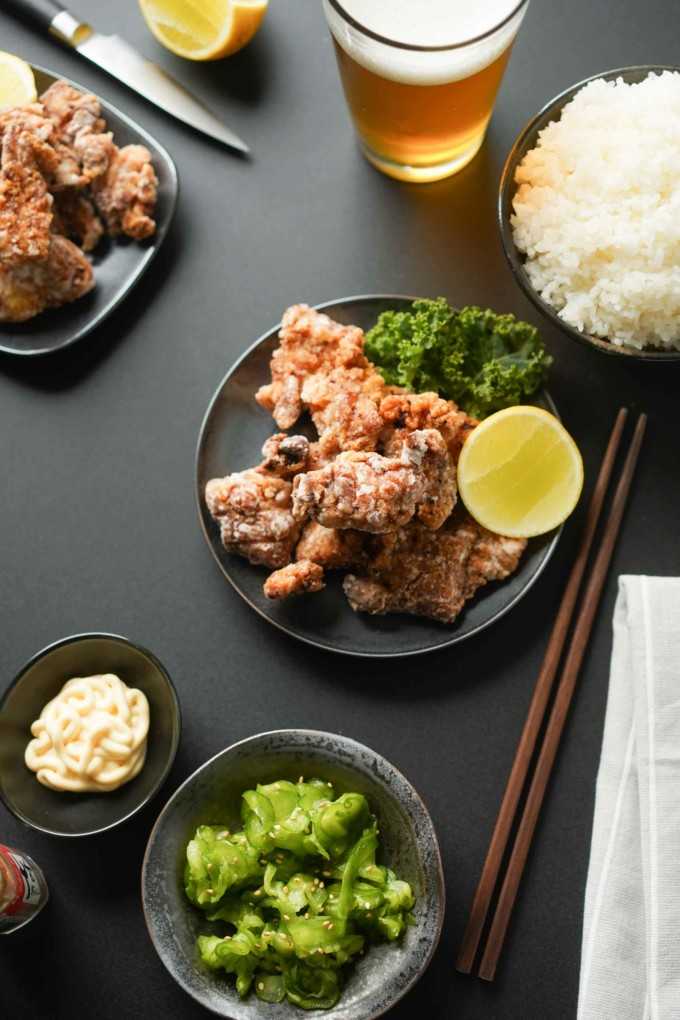
It probably doesn’t need to be said, but these bite-sized pieces are best eaten as soon as possible to take advantage of the crunch since the ideal window is within only a few minutes. They’re actually still ok about 20-30 minutes later, but still not peak crunch.
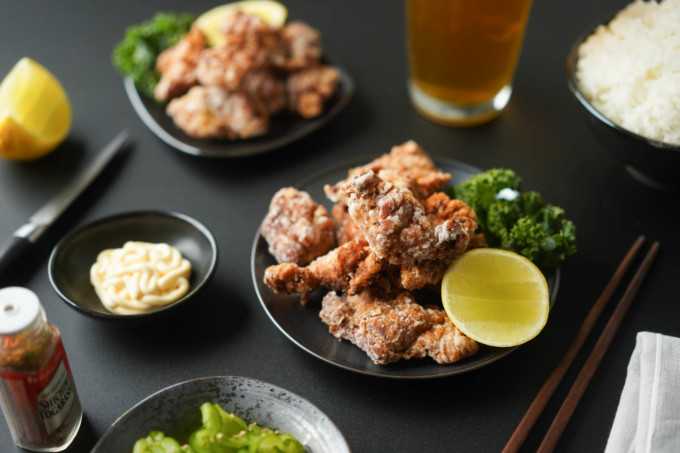
The great thing about karaage is that they are still really good if you re-bake in the oven even a few days later (or for that morning after carb-filled breakfast).
I like to eat them with fresh squeeze of lemon juice and a side of Japanese mayo (Kewpie brand) topped with Shichimi Togarashi. Some other Japanese foods to eat with karaage is yakitori, shrimp tempura and takoyaki (Japanese octopus balls).
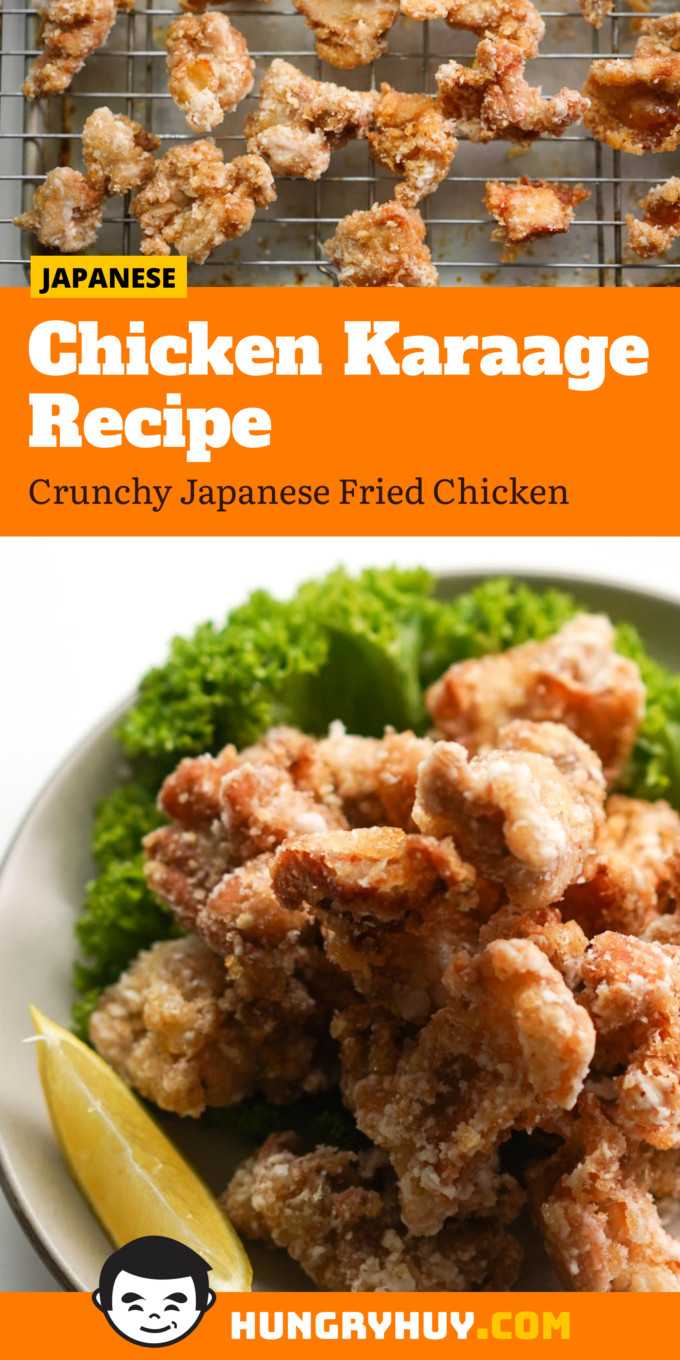
Chicken Karaage Recipe (Japanese Fried Chicken)
5 from 9 votes
Treat yourself to extra crispy bites of juicy fried chicken with this karaage recipe. I bet you can’t say no to just one piece!
BY: Huy Vu
Prep: 15 minutes mins
Cook: 15 minutes mins
Marinating: 6 hours hrs
Total: 6 hours hrs 30 minutes mins
SERVINGS: 6
Ingredients
- ▢ 2 lb chicken thighs skin-on, de-boned, & cut into 1 inch pieces
- ▢ 2 ¾ fl oz (5 ½ tbsp) soy sauce
- ▢ 1 fl oz (2 tbsp) sake
- ▢ 8 g fresh grated ginger
- ▢ 10 g grated garlic
- ▢ ⅓ fl oz (⅔ tbsp) mirin
- ▢ vegetable oil
- ▢ 200 g potato starch or cornstarch
Optional dipping / sides
- ▢ lemon wedges
- ▢ Japanese mayonnaise Kewpie brand
- ▢ Shichimi Togarashi
Instructions
- De-bone your chicken thighs and cut into 1 inch, bite-sized pieces.
- In a bowl, add soy sauce, sake, ginger, garlic, and mirin together and stir until all ingredients are combined.
- Add the 1-inch chicken pieces to a container with a lid (I like to use glass food storage containers with a rubber seal for marinating because it seals liquids properly).
- Mix in the marinade and stir to cover all the pieces of chicken. Close the lid and leave in the refrigerator for at least 6 hours. You will want to check at the 4 hour mark and give it a mix to ensure even coverage.
- After your chicken is done marinating, pour about 1 ½ inches of vegetable oil in a heavy bottomed pot and heat to 375 °F degrees.
- Measure out 200 grams of potato starch into a shallow bowl. Lightly flour each piece of chicken into the potato starch. Add more starch to the bowl if necessary. If you can’t find potato starch, you can also substitute it for cornstarch.
- Immediately after breading, you want to slowly lower each chicken piece into the heated oil. Make sure to not crowd the pieces to ensure proper frying.
- Cook each piece for about 3-5 minutes depending on the size, or until golden brown.
- Remove the chicken and place on a cooling rack or paper towels to remove excess oil.
- Serve the karaage with lemons and Japanese mayonnaise (Kewpie brand) topped with Shichimi Togarashi, if you want an extra kick. Enjoy!
Nutrition Facts (per serving)
Calories: 494kcal | Carbohydrates: 32g | Protein: 29g | Fat: 27g | Saturated Fat: 7g | Polyunsaturated Fat: 1g | Monounsaturated Fat: 1g | Cholesterol: 152mg | Sodium: 911mg | Potassium: 703mg | Fiber: 3g | Sugar: 2g | Vitamin A: 118IU | Vitamin C: 11mg | Calcium: 44mg | Iron: 2mg
Nutrition Facts
Chicken Karaage Recipe (Japanese Fried Chicken)
Amount per Serving
Calories
494
% Daily Value*
Fat
27
g
42
%
Saturated Fat
7
g
44
%
Polyunsaturated Fat
1
g
Monounsaturated Fat
1
g
Cholesterol
152
mg
51
%
Sodium
911
mg
40
%
Potassium
703
mg
20
%
Carbohydrates
32
g
11
%
Fiber
3
g
13
%
Sugar
2
g
2
%
Protein
29
g
58
%
Vitamin A
118
IU
2
%
Vitamin C
11
mg
13
%
Calcium
44
mg
4
%
Iron
2
mg
11
%
* Percent Daily Values are based on a 2000 calorie diet.
Did you cook this recipe?Tag @HungryHuy or #hungryhuy–I’d love to see it!
Karaage (Japanese Fried Chicken)
4.78 from 336 votes
Karaage (Japanese Fried Chicken) is easily one of the greatest types of fried chicken in the world. It’s exceptionally flavorful, juicy, ultra-crispy, and absolutely worth hanging out at the stove for! Learn the simple techniques and fry up some glorious chicken at home today.
Ingredients
US CustomaryMetric
1x2x3x
- ▢ 1½ lb boneless, skin-on chicken thighs (4–6 pieces per 1½ lb, 680 g; read the blog post)
- ▢ ½ tsp Diamond Crystal kosher salt
- ▢ freshly ground black pepper
For the Marinade
- ▢ 1 knob ginger (1 inch, 2.5 cm for 4 servings)
- ▢ 1 clove garlic
- ▢ ½ Tbsp soy sauce
- ▢ ½ Tbsp sake (or substitute with dry sherry, Chinese rice wine, or omit)
- ▢ ½ tsp roasted sesame oil
For Deep-Frying
- ▢ 4 cups neutral-flavored oil
- ▢ 2 Tbsp potato starch or cornstarch (plus more, if needed)
- ▢ 2 Tbsp all-purpose flour (plain flour) (plus more, if needed)
For Serving (optional)
- ▢ lemon wedges
- ▢ Japanese Kewpie mayonnaise
- ▢ shichimi togarashi (Japanese seven spice)
Japanese Ingredient Substitution: If you want substitutes for Japanese condiments and ingredients, click here.
Instructions
To Marinade the Chicken
-
To prepare 1½ lb boneless, skin-on chicken thighs, cut each chicken thigh into 2-inch (5-cm) pieces. Season with ½ tsp Diamond Crystal kosher salt and freshly ground black pepper.
-
Add ½ Tbsp soy sauce, ½ Tbsp sake, and ½ tsp roasted sesame oil to the bowl with the ginger and garlic. Whisk it all together.
-
Add the chicken to the bowl with the marinade and mix it with your hands. Cover and keep in the refrigerator to marinate for 30 minutes.
To Prepare the Deep Frying Oil
While the chicken is marinating, prepare the oil for deep-frying. Pour 4 cups neutral-flavored oil into a heavy-bottomed pot (I used a Dutch oven) and heat it to 325ºF (163ºC) on medium heat.
To Dredge the Chicken
-
While the oil is heating up, dredge the chicken. Prepare 2 Tbsp all-purpose flour (plain flour) and 2 Tbsp potato starch or cornstarch in separate piles.
-
Lightly dredge a marinated chicken piece in the flour and dust off the excess flour. Then, dredge in the potato starch and remove the excess starch.
-
Continue with the remaining chicken pieces.
To Deep-Fry
-
When the oil is hot enough, gently submerge 3 to 5 chicken pieces in the oil at a time; do not overcrowd the pot. Tip: If you put too many pieces in at once, the oil temperature will drop quickly, and the chicken will end up absorbing too much oil.
-
First Deep-Frying: Deep-fry for 90 seconds, or until the outside of the chicken is a light golden color. If the chicken browns too quickly, then the oil temperature is too high. Either put a few more pieces of chicken in the oil or lower the heat. Controlling the oil temperature at all times is very important for deep-frying. Transfer the chicken pieces to a wire rack to drain the excess oil.
-
The residual heat will continue to cook the chicken as it rests on the wire rack. Continue deep-frying the remaining chicken pieces. Between batches, pick up and discard the crumbs in the oil with a fine-mesh sieve. This keeps the oil clean and prevents it from becoming darker.
-
Second Deep-Frying: Now, heat the oil to 350ºF (177ºC). Place 3 to 5 pieces of the resting chicken back into the oil and deep-fry for 45 seconds, or until the skin is golden brown and crispy. Transfer them to a wire rack to drain the excess oil. Continue with the remaining chicken pieces.
-
The left photo shows the chicken pieces after the first frying and the right photo shows them after the second frying. You can see the chicken pieces on the right are slightly darker in color.
To Serve
Serve the chicken hot. We often serve Karaage with lemon wedges and dip it in Japanese Kewpie mayonnaise (you can make it homemade). Sprinkle shichimi togarashi (Japanese seven spice) on top for a bit of spice, if desired.
To Store
Deep-fry all the chicken pieces, let cool completely, and keep in an airtight container. You can store it in the refrigerator for up to 3 days and in the freezer for up to a month.
Nutrition Facts
Karaage (Japanese Fried Chicken)
Amount per Serving
Calories
531
% Daily Value*
Fat
42
g
65
%
Saturated Fat
19
g
119
%
Trans Fat
1
g
Cholesterol
167
mg
56
%
Sodium
254
mg
11
%
Potassium
411
mg
12
%
Carbohydrates
8
g
3
%
Fiber
1
g
4
%
Sugar
1
g
1
%
Protein
29
g
58
%
Vitamin A
133
IU
3
%
Vitamin C
1
mg
1
%
Calcium
19
mg
2
%
Iron
1
mg
6
%
* Percent Daily Values are based on a 2000 calorie diet.
Author: Nami
Different Flavours
Karaage can come in all kinds of different flavours!
| Common | Uncommon |
| Salt base (shio karaage) | Spicy/hot |
| Soy sauce base (shoyu karaage) | Garlic |
| Basil | |
| Cheese | |
| Curry | |
| Ume (pickled plum) |
You can create different flavours by using different marinades or adding different herbs and spices to the flour. One thing to note is you don’t want your karaage to be overpowered with too much flavour, I actually think simple is better for this dish. You also don’t need to marinate any longer that 30 minutes, 30 minutes is pretty much the perfect amount.
Today, I’m going to tell you fairly basic way to make authentic karaage with a salt base, if you like fried chicken in general, it’s definitely worth a try!




























